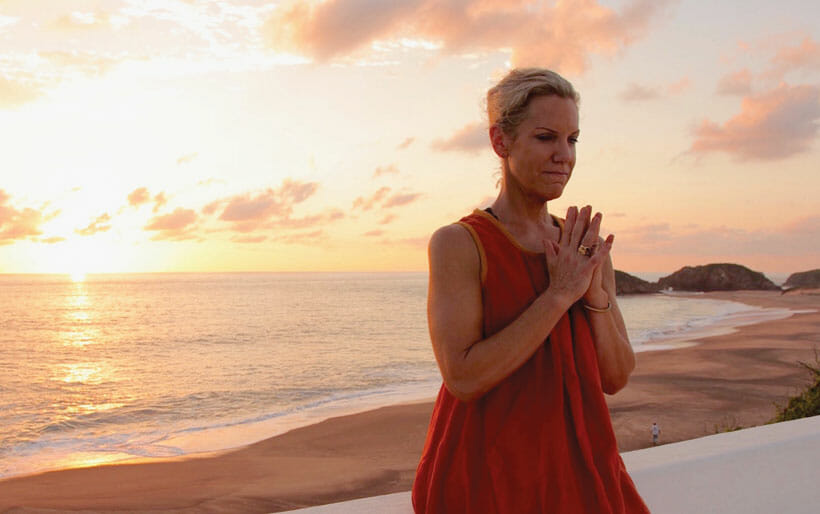
Andrea Marcum, Author of Close to Om
Savasana is one of our most important practices. In relaxation, we can take time to stop in order to get started.
Awaken to the fact that you must stop in order to start.
You most likely know savasana (or corpse pose) as that moment at the end of a yoga practice when you stop and lie down. I’m going to tell you savasana is the beginning.
When you stop to take a flower in your hand and really look at it, it’s your world for that moment. (Georgia O’Keefe)
Savasana is the perfect place for us to S.T.O.P. so that we can S.T.A.R.T.
- Stop moving, fixing, fidgeting, thinking about the past or anticipating the future.
- Take one breath at a time.
- Observe. Is your jaw tight? Does something itch?
- Are you tapping your fingers or fidgety in your feet?
- What are you feeling? Thinking? Hearing?
- Just notice.
- Pause before proceeding.
- Resist the temptation to jump ahead and move on.
- Let yourself simply be here observing for a moment.
Implement the stages we need to S.T.A.R.T.
S. Start to make space. Space is where possibility lives. Feel the capacity to create space in your body, mind, and breath. Start with the space between your fingers and toes, between your shoulders and your ears, and between your inhales and exhales.
T. Turn down the volume. Feel as though you have your hand on the volume knob of negative chatter, distractions, and excuses, and start to turn the volume down.
A. Accept and acknowledge. Accept where you are right now and start to acknowledge room for expansion and improvement without finding fault.
R. Renew. Let spacious, quiet acceptance facilitate your new start.
T. Take thoughtful action.
Only then can we awaken. Awakening is the first step in a shift toward positive change. In our body and mind we’re like those snow globes you shake and fill with chaotic, blind- ing snow until we stop, breathe, and let the snow of our agitated bodies and overstimu- lated minds subside—allowing us to awaken to the landscape within.
When we S.T.O.P. we can let go of our elusive quest for worldly solutions to our unhappiness, and S.T.A.R.T. to allow a quieter, more genuine joy to come to the surface.
Pause to Be Instead of Do
It’s a pause for us to “be” instead of perpetuating the constant and tumultuous “doing” our lives can be reduced to. The anticipation of knowing we have to rush to reach our destination, meet our deadline, or live up to imposed expectations can be a real buzz kill, making it nearly impossible to sit still.
But if we don’t S.T.O.P. the madness, how can any of us shift our internal climate from turbulent to temperate?
As a yoga teacher, I’ve watched thousands of agitated bodies, tapping hands and feet, darting eyes and clearly spinning minds struggle to stay where they are until I set them free.
Restlessness can be very convincing. In my classes I have some serial savasana duckers, those who skip it and leave early every time. As a student even I have had those times where I’ve spent almost the entire class planning my escape, plotting the moment when I could slip out unnoticed and hurl myself back into the comfort of the insanity outside. Only to be reassured that like an unfinished conversation, leaving midstream is never satisfying.
Discover Ourselves in Increments
So how do we access this subtle landscape that leads us ultimately to more freedom, calm, and possibility? Just as we do with athletic poses like arm balances and backbends, we need to allow ourselves to discover in increments.
I believe it’s important to start by breaking things into manageable bits. I’m not asking you to sign a contract for twenty-minute headstands, days of solemn silence, and zero signs of fun—just bite-sized, easily digested practices you can do consistently before you decide whether you’re going to the gym or if you should reach for the remote, sautéing or steaming your broccoli, and if you should return those shoes you bought.
In my classroom, before we begin, the first thing we do is S.T.O.P. so that we can S.T.A.R.T. We climb onto our mats and into a child’s pose or comfortable seat to pause and let both ourselves and the room settle. Though physically we may not be sprawled out on the floor in the typical savasana position, mentally and emotionally we are taking a savasana of sorts.
As you begin your journey Close to OM you must do the same,
S.T.O.P. to S.T.A.R.T.—create a conscious savasana time-out so you can tune in.
B. K. S. Iyengar likens savasana to a snake shedding its dead skin to reveal the vibrant colors of newness beneath. Our S.T.O.P. to S.T.A.R.T. savasana practice allows us to let go of what is not needed so we can blossom anew.
Savasana On Your Mat
In the book Close to Om, we do a number of exercises together that involve marinating in the assignment for a certain amount of time. First, you’ll read through the instruction, then you’ll use any method of time-keeping that works for you: your phone, a setting on your watch, a good old fashioned cooking timer, or you can use @OM in the dropdown menu at www.closetoOM.com.
There you’ll find audio guidance for the exercise you’ve just read, and the timing is all taken care of for you.
Read Julie Pilat’s review of Close to OM here.
Personalize Your Practice
Within the pages of Close to Om, you and I may find ourselves doing the same yoga pose, but we will never have exactly the same experience while we’re in it. Some of us are inspired to expedite the end zone, while others enjoy a slower, more methodical strategy. Personally, I’ve come back to this material over and over again, year after year—sometimes moving through things linearly and often revisiting and lingering in specific chapters and principles that speak to me at that moment.

Just like modifying the postures themselves so they best suit you, I encourage you to find your own tempo, pace, and schedule. Though I appreciate an eight-weeks-to or twenty-eight-days-to format for books and programs designed to motivate us, I see our progression of awaken, transform, and unite as ongoing and alive, as the architecture of every yoga practice, every relationship, every day, and every season of our constantly changing lives. I believe we have the opportunity to begin again and again, with every breath and in myriad situations. But you have to really do it. You have to climb out of the stands and onto the field.
We’re going to find our way into a classic savasana pose and take some time to appreciate the inherent S.T.O.P. to S.T.A.R.T that lives within it.
Practicing Savsana
Lie down on your back, arms along your sides but not glued to your ribs, legs a little bit wider than hip distance apart. Allow your feet to naturally fall open a bit. If your lower back is tender, you might prefer to bend your knees and put your feet on the ground. Snuggle your shoulder blades to melt down your back instead of riding up into your ears. Feel the back of your head and the backs of your hands heavy into the ground. Let your fingers crinkle toward your palms with relaxation.
Appreciate the support of the earth beneath you, how it literally has your back, reinforcing safe surrender. Imagine your muscles turning into liquid and that liquid seeping into the floorboards beneath you, your bones sinking into the ground as if elementally returning to the earth. Yield to these bodily sensations and allow the blizzard of thoughts and stories in your snow globe head to succumb to the calm resolve.
Reach full S.T.O.P.—body and mind and stay here for five minutes using your timer or @OM.
Savasana On Your Om
We can S.T.O.P. to S.T.A.R.T. anywhere at any time—in your office when you’re ready to strangle your boss, in your parked car after dropping off screaming kids, when you’ve tried in vain to reach an actual human being instead of an automated phone menu, or before starting a new project or task.
Begin by taking little S.T.O.P. to S.T.A.R.T. savasanas throughout the day. You don’t have to take the actual pose like you did On Your Mat (though you’re welcome to), but you will find your way toward the palpable calm you felt while in the posture.
Sit without returning a text or e-mail, pause without planning, stand and close your eyes without seeing your shopping list . . . just for thirty seconds. Try to fit three in per day. Set your timer or use @OM.
When you feel you are arriving at thirty seconds, try a full minute, then maybe even two. Notice how it stops the confusion and provides you with a new platform from which to start again.
As Anne Lamott says, “Almost everything will work again if you unplug it for a few minutes, including you.”
